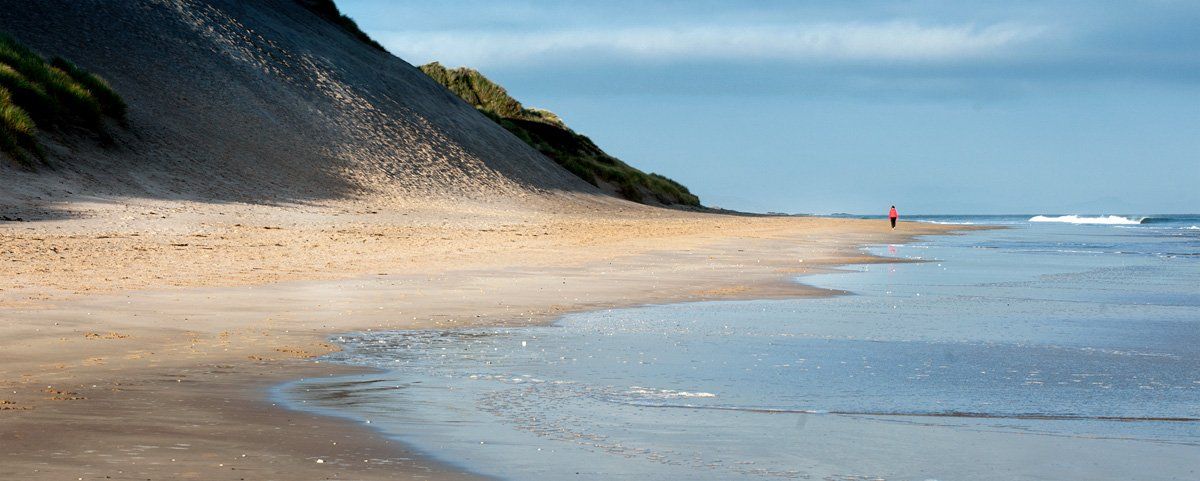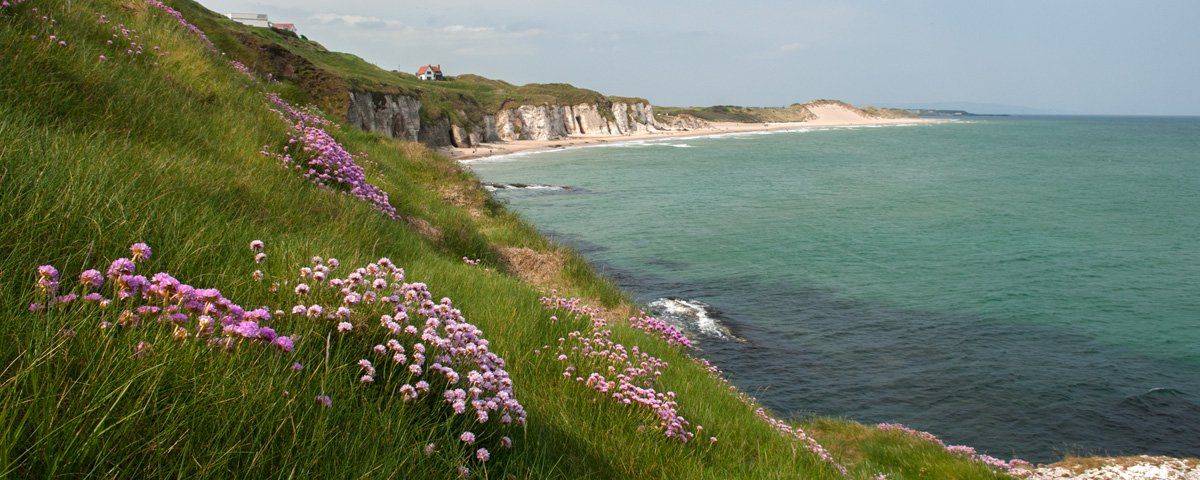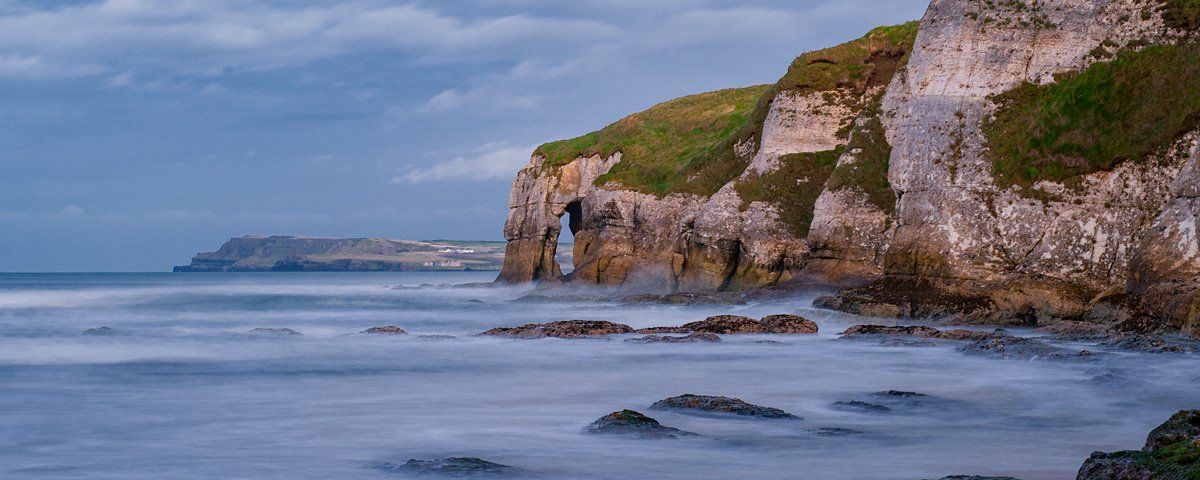The White Rocks
Stretching from Curran Strand to Dunluce Castle are the unique limestone cliffs of the White Rocks. These soft sedimentary rocks have been carved through centuries into a labyrinth of caves, arches and inlets, magical headlands of distinguishable forms rise out of the ocean with names like Shelagh's Head, the Giants Head, the Wishing Arch, Elephant Rock, the Lion's Paw and the Lord Mayor's Parlour, while underneath the road you drive upon, huge cavernous caves, accessible only from the sea are home to scores of seabirds and the hunting ground for hawks. On the main coast road, you will find pull-in areas and also a large car park at Magheracross where you can take in the incredible views of the headlands to the Giants Causeway and back to Portrush and Donegal.
The cliffs are best viewed along the pathway or better still from a boat, where the true beauty and awe of the many arches can be appreciated. The beach area has many grassy knolls with sea views and is ideal for picnics, car parking, toilet facilities and a shower are also located close to the beach. You will also find the second-largest dune in Ireland situated a few hundred metres up the beach, the largest being at Ballyness, Donegal. One word of caution, make yourself aware of the location of the two rip currents that are active at the White Rocks, these are easily avoided but dangerous to the unaware. Most beaches have rip currents which are a natural part of beach dynamics.
What you see of the White Rocks from the land is only a fraction of what lies below the cliffs where time has shaped some truly spectacular caves and arches. Victorian holidaymakers would visit these locations frequently to picnic during the summer months, as many old postcards of the area depicted. I have traversed the base several times from the White Rocks to Dunluce Castle and beyond. For the keen adventurer, it is a memorable experience though with some risk involved, for once you go down at Ballymagarry there is only one steep and difficult way out between there and Dunluce Castle. A flat calm sea with no swell is a must and local knowledge of the tides and rip currents advisable, swimming is required at several points along the route.
There are numerous caves and arches to enjoy, varying in size but each with its own uniqueness. Cathedral cave is perhaps the most impressive with three arches, other caves along the way include the Heart Cave, Teardrop Cave, Lord Antrim's Parlour and many more. Boats from Portrush would bring Victorian holidaymakers round to view the caves from the sea while up above the tramway made its way from the 'Port' to the Giant's Causeway. Several shipwrecks have also taken place here. In 1782 the French brig 'De Sci' was lost between Portrush and the White Rocks - a little east of the main point of Curran Strand. The ship had a valuable cargo on board and was bound for Ponticherry, in the East Indies, the contents being supplies for the French army.
She was captured by an English privateer off Donegal, both ships then ran into a heavy northerly gale and made for the Skerries Roads losing sails as they went. Some crew from the English privateer were aboard the 'De Sci' which went too far east of the Skerries and in the gale force winds was driven aground on the White Rocks beach. The privateer managed to get into a safe shelter and rode out the gale. All the cargo that was saved from the 'De Sci' was taken to a Mr Hunter's of Ballymagarry who was Lord Antrim's agent and receiver of wrecks. Whether myth or fact, nobody can say but word spread that the French Captain had before being taken as a prisoner, tied all his money around his waist and when he realized that there was no escape, leapt overboard off the Skerries.
It was also told by local people that there was a large chest on board full of money to pay the French soldiers waiting for the De Sci to arrive in the East Indies, this was never found. The fact that the ship was going out to re-supply French soldiers adds some substance to the story of lost treasure, maybe, somewhere close to the White Rocks, it still lies waiting to be found. In 1844 the schooner 'Charley' loaded with oatmeal in Portrush and bound for Scotland came to anchor in the shelter of the Skerries after encountering a strong headwind on leaving Portrush. The wind veered to the south and then increased to gale force, she dragged her anchor and ended up on the rocks.
This was during the famine times in Ulster and oatmeal was selling at five shillings for 20lb, many people were in need of food locally who could not afford this price. As the gale subsided people with boats headed out to the ship and unloaded the cargo, dispersing it amongst those in need, there were no fatalities in this wreck. On 17th June 1851, a large brig called the 'Charlotte' of St John, New Brunswick bound for Portrush with a load of timber, was wrecked on Rathmore Head trying to get to the shelter of the Skerries due to not enough water to enter the harbour. No lives were lost in this wreck either. In 1863, The MacDuff schooner 'Providence' was on route from Troon to Portrush with a cargo of coal, as she came by Bengore the wind came up from the west, which was dead ahead.
She managed to get up to the Skerries but could not get into the sheltered deeper water and stood off the White Rocks. She dropped her two anchors, unfortunately, the wind veered to the north-west and she dragged her anchors and grounded in the breakers. Being in the breakers she broke up and her crew were washed off, three of them were drowned including the Captain Robert Jack. Two boats came out from the shore to give assistance, one with a crew of fishermen and the other with coastguard men, they also got into difficulties in the surf with the loss of fishermen David Martin, John Hammond, and Jack Winters of the coastguard. The following information was kindly provided by Marian Arnot. Her great grandfather was Captain Robert Jack.
Robert Jack was born in Ireland in 1831, his father was John Jack also a seaman, so possibly Robert’s mate on the Providence when it sank. Robert married Mary Ann Caughlin on 28 August 1855 at the Parish Church of Stepney, Middlesex, England. Their residence at time of marriage was 9 Anthony Street. Mary Ann was a widow; her first husband's surname was Sullivan, we believe Mary was also born in Ireland in 1831. They had four children: Leonora, Theresa, Agatha and Jack born between 1853 /1955. Robert Poeg Jack born possibly 1860, at sea, Died – unknown. Richard William Jack Born – possibly 1860, at Sea - Died – unknown. Margaret Ann Jack Born – 27 September 1963 in Portrush, Ireland. Died – 28 January 1943 in Wellington, NZ.
My Great Grandmother is Margaret Ann Jack she was less than 3 months old when her father died. She grew up in a Catholic orphanage in Portrush. Last year I emailed Alison at the Catholic Church in Portrush for any information on Margaret Jack, in particular about any orphanages there in the 1860s, but she found no records of any Jack's. I contact Father Sheehan at the Roman Catholic Church but I have not heard back, we believe Robert's widow Mary Ann moved to Belfast as we have a copy of a Liquor License application with support from a Portrush residence. It seems Mary Ann went on to remarry someone with the surname Heslip, but we know nothing else of her. At least three of the four siblings seem to have stayed in contact, one of the brothers was living with Margaret Ann and her family in West Ham (as found in a Census of 1891), and Leonora had been living in West Ham for some time. Some of Leonora’s family immigrated to NZ, and in 1921 after Margaret’s 2nd husband had died, at the age of 58, she immigrated to NZ with her children.










